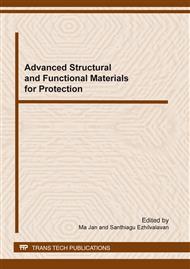p.1
p.5
p.9
p.12
p.15
p.18
p.21
p.25
p.28
Corrosion Resistance of Pulse-Electroplated Ni-W Alloys
Abstract:
Nickel-tungsten (Ni-W) plating process exhibited fewer environmental hazards and lower health hazards than conventional chromium bath processes did, because they had the potential to be substituted for certain future applications. This study attempted to develop Ni-W alloy coatings with different weight percentages of tungsten to produce by using nickel-tungsten citrate electrolyte baths that are deposited by pulse current power source techniques. The composition of the ratio of tungsten/nickel was controlled by the change from ion mass transfer rates for the interface between cathodes and electrolytes that were caused by adjustment by charging the over potential or rest that was regulated by the on-off time during pulse and reverse-pulse current. In this study, the corrosion resistance and the composition of the coatings related to the operating parameters were also discussed through the analyses of the experimental design method. Results were found that Ni-W alloy compositions governed through regulation of pulse and pulse-reverse parameters. The frequencies of electric current, Ton and Toff with pulse duty cycles had great impact on chemical composition and surface morphology for the deposits. Results of the electrochemical tests indicated the pulse plated Ni-W metal alloy coatings in which the corrosion resistance was superior to that of the alloy deposited by the direct current technique.
Info:
Periodical:
Pages:
15-17
Citation:
Online since:
February 2012
Authors:
Keywords:
Price:
Сopyright:
© 2012 Trans Tech Publications Ltd. All Rights Reserved
Share:
Citation:


